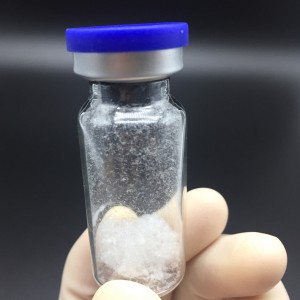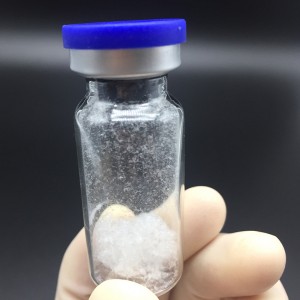Desmopressin Acetate lati tọju Insipidus Àtọgbẹ aarin
Alaye ọja
| Oruko | Desmopressin |
| nọmba CAS | 16679-58-6 |
| Ilana molikula | C46H64N14O12S2 |
| Ìwúwo molikula | 1069.22 |
| Nọmba EINECS | 240-726-7 |
| Yiyi pato | D25 +85.5 ± 2° (ṣe iṣiro fun peptide ọfẹ) |
| iwuwo | 1.56±0.1 g/cm3(Asọtẹlẹ) |
| RTECS No. | YW9000000 |
| Awọn ipo ipamọ | Tọju ni 0°C |
| Solubility | H2O:soluble20mg/ml, ko o, awọ |
| olùsọdipúpọ acidity | (pKa) 9.90± 0.15 (Asọtẹlẹ) |
Awọn itumọ ọrọ sisọ
MPR-TYR-PHE-GLN-ASN-CYS-PRO-D-ARG-GLY-NH2; MINIRIN; [DEAMINO1, DARG8] VASOPRESSIN; [DEAMINO-CYS1, D-ARG8] -VASOPRESSIN; DDAVP, ENIYAN; DESMOPRESSIN; DESMOPRESSIN, ENIYAN; DESAMINO-[D-ARG8] VASOPRESSIN
Awọn itọkasi
(1) Itoju insipidus atọgbẹ aarin. Lẹhin oogun naa le dinku iyọkuro ito, dinku igbohunsafẹfẹ ito ati dinku nocturia.
(2) Itoju enuresis nocturnal (awọn alaisan ti o wa ni ọdun 5 tabi agbalagba).
(3) Ṣe idanwo iṣẹ ifọkansi ito kidirin, ati ṣe iwadii iyatọ ti iṣẹ kidirin.
(4) Fun hemophilia ati awọn arun ẹjẹ miiran, ọja yii le dinku akoko ẹjẹ ati dena ẹjẹ. O le dinku iye isonu ẹjẹ intraoperative ati oozing postoperative; paapaa ni apapo pẹlu titẹ ẹjẹ ti o ni oye ti iṣakoso lakoko iṣẹ-abẹ, o le dinku ẹjẹ inu iṣan lati awọn ọna ṣiṣe ti o yatọ, ati dinku eewu lẹhin iṣẹ abẹ, eyiti o le ṣe ipa ti o dara julọ ni aabo ẹjẹ.
Itoju ti insipidus àtọgbẹ
Àtọgbẹ insipidus jẹ nipataki rudurudu ti iṣelọpọ omi ti a ṣe afihan nipasẹ iṣelọpọ ito pupọ, polydipsia, hypoosmolarity, ati hypernatremia. Aipe apa kan tabi pipe ti vasopressin (insipidus àtọgbẹ aarin), tabi aipe kidirin ti vasopressin (nephrogenic diabetes insipidus) le bẹrẹ. Ni ile-iwosan, insipidus àtọgbẹ jẹ iru si polydipsia akọkọ, ipo kan ninu eyiti gbigbemi omi ti o pọ julọ jẹ nitori aiṣedeede ti ẹrọ ilana tabi ongbẹ ajeji. Ni ilodisi si polydipsia akọkọ, ilosoke ninu gbigbemi omi ni awọn alaisan ti o ni insipidus àtọgbẹ jẹ idahun ti o baamu si awọn ayipada ninu titẹ osmotic tabi iwọn ẹjẹ.










